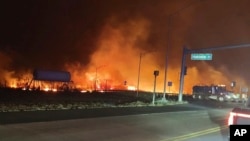Additional equipment such as fire trucks or water tankers would have helped the Maui Fire Department fight the deadliest U.S. wildfire in more than a century last August, the agency said on Tuesday.
Wildfires were burning in several locations in Maui on August 8, 2023, stretching the department's limited resources. A severe windstorm made battling the flames difficult, and the blaze in Lahaina quickly tore through the historic town, killing 101 people and destroying thousands of homes. Crews used personal vehicles and even a moped to try to rescue residents from the flames, the department said.
The need for additional firefighting equipment is one of 17 recommendations included in an after-action report produced for the department by the Western Fire Chiefs Association. The report details what went well when the department responded in Lahaina, Olinda and Kula on August 8, as well as improvements that can be made, Assistant Fire Chief Jeff Giesa said.
Giesa and Fire Chief Brad Ventura discussed the report during a news conference in Kula on Tuesday morning and said the full document would be released later that day.
"There were firefighters fighting the fires in Lahaina as they well knew their homes were burning down," Ventura said. "There were firefighters who rescued people and kept them in their apparatus for several hours as they continued to evacuate others."
One off-duty safety officer repeatedly drove his personal moped into the fire zone to rescue people, according to Ventura, and other firefighters drove their own cars to the perimeter and ran and hiked inside to evacuate people.
"While I'm incredibly proud of our department's response, I believe we can always improve our efforts," Ventura said.
One of the recommendations in the report is that the department keep their relief fire equipment fully stocked, he said. Other recommendations include creating a statewide mutual aid program and a statewide evacuation plan for residents who speak different languages.
Many of the factors that contributed to the disaster are already known: A windstorm battering the island had downed power lines and blown off parts of rooftops, and debris blocked roads throughout Lahaina.
Hawaiian Electric has acknowledged that one of its power lines fell and caused a fire in Lahaina the morning of August 8, but the utility company denies the morning fire caused the flames that burned through the town later that day.
The vast majority of the county's fire crews were already tied up fighting other wildfires on a different part of the island, their efforts sometimes hindered by a critical loss of water pressure after the winds knocked out electricity for the water pumps normally used to load firefighting tanks and reservoirs. County officials have acknowledged that a lack of backup power for critical pumps made it significantly harder for crews to battle the Upcountry fires.
A smaller firefighting team was tasked with handling any outbreaks in Lahaina. That crew brought the morning fire under control and even declared it extinguished, then broke for lunch. By the time they returned, flames had erupted in the same area and were quickly moving into a major subdivision.
"Our firefighters are well-trained, they are well-equipped. They are basically forced to make decisions every single day with the best information available," Giesa said of the crew leaving. "It's 20-20 hindsight, but our crews did everything that they normally do on fires."
Cellphone and internet service were also down in the area at times, so it was difficult for some to call for help or to get information about the spreading fire — including any evacuation announcements. And emergency officials did not use Hawaii's extensive network of emergency sirens to warn Lahaina residents.
The after-action report also recommends that officials undertake an analysis of the island's cellular system, Ventura said.
The high winds made it hard at times for first responders to communicate on their radios, and 911 operators and emergency dispatchers were overwhelmed with hundreds of calls.
Police and electricity crews tried to direct people away from roads that were partially or completely blocked by downed power lines. Meanwhile, people trying to flee burning neighborhoods packed the few thoroughfares leading in and out of town.
The traffic jam left some trapped in their cars when the fire overtook them. Others who were close to the ocean jumped into the choppy waters to escape the flames.
The fire department's after-action report comes one day before the Hawaii Attorney General is expected to release the first phase of a separate comprehensive investigation about the events before, during and after the fires.
The reports could help officials understand exactly what happened when the wind-whipped fire overtook the historic Maui town of Lahaina, destroying roughly 3,000 properties and causing more than $5.5 billion in estimated damage, according to state officials.
A similar after-action report was released by the Maui Police Department in February. It included 32 recommendations to improve the agency's disaster response, including that the department obtain better equipment and station a high-ranking officer in the island's communications center during emergencies.










